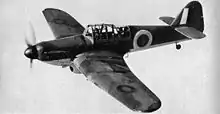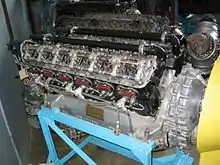| Kestrel | |
|---|---|
 | |
| Rolls-Royce Kestrel XVI at the Royal Air Force Museum Cosford | |
| Type | Piston V-12 aero engine |
| Manufacturer | Rolls-Royce Limited |
| First run | Late 1926 |
| Major applications | Hawker Hart Miles Master |
| Number built | 4,750 |
| Developed into | Rolls-Royce Goshawk Rolls-Royce Peregrine |
The Rolls-Royce Kestrel (internal type F) is a 21.25 litre (1,295 in³) V-12 aircraft engine from Rolls-Royce. It was their first cast-block engine, and used as the pattern for most of their future piston-engine designs.[1] Used during the interwar period, it was fitted to a number of British fighters and bombers of the era, including the Hawker Fury and Hawker Hart family, and the Handley Page Heyford. The Kestrel engine was also sold to international air force customers, in this role it used to power prototypes of the German Messerschmitt Bf 109 and the Junkers Ju 87 "Stuka" dive-bomber, as the Junkers Jumo 210 engines were not ready to be fitted.[2] Several examples of the Kestrel engine remain airworthy today.
Design and development
Origin
Earlier in-line engine designs were generally built on top of a cast aluminum crankcase, with the cylinders, individually-machined steel cylinders, bolted on top. Given the forces involved, the system connecting the cylinders to the crankcase had to be robust, adding weight, and as a whole the engine was reliant on the structure of the crankcase to hold it together.
In 1923, the Curtiss CR won the 1923 Schneider Trophy. The CR was powered by the recent introduced Curtiss D-12 engine, which replaced the individual cylinders with a cast aluminum block. This gave the engine much greater strength, allowing the rest of the engine to be greatly simplified, making it much lighter overall, as well as easier to assemble as the two parts simply bolted together in a single operation. It was also easy to convert existing assembly lines to the new system as the cast blocks were already being produced for the crankcase, and all that was required was new machines to mill the blocks to the accuracy needed for the pistons.[3]
The Curtiss D-12 was one of the most powerful engines of its era, and continued to exchange records with other contemporary high-power engines such as the Napier Lion. At the time, none of the British aero engine manufacturers could offer an engine which offered a similar power rating which was also as light and compact as the D-12. The D-12 was licensed by Fairey and introduced to the UK as the Felix.
Arthur Rowledge, Chief Designer at Napier and the designer of the Napier Lion engine, joined Rolls-Royce in 1921 to take up the roll as "Chief Assistant to Mr F. H. Royce".[4][5] Rowledge built a team to introduce a new engine using the cast block, but set the goal to surpass the D-12. This would be accomplished using supercharging at all altitudes, allowing it to outperform naturally aspirated engines. Previously, supercharging (and turbocharging) was primarily used for high-altitude designs, to offset the loss of ambient air pressure as the aircraft climbed and thereby maintain power. But with the new construction technique, the engine would be so strong that it could be supercharged at all altitudes without overstressing the cylinders, allowing a smaller engine to operate as if it was larger, and thus improving its power-to-weight ratio.
The prototype Kestrel engine was first run in 1926, and one first flew in 1927, with a power rating of 450hp (335kW). The engine was normally aspirated in its initial form.
Improvements

The engine was first produced in 1927 at 450 hp (335 kW), which was soon improved in the I-B version to 525 hp (390 kW) by increasing the compression ratio to 7:1. The I-B variant saw widespread use in the Hawker Hart family of aircraft, a mainstay of British air power during the early 1930s.
Development continued and the V model introduced the centrifugal supercharger, increasing power to 695hp (520kW).
Increased availability of higher octane aviation fuels in the late 1930s allowed the engine to be boosted to higher power levels without suffering from detonation. The mark-XVI engine used in the Miles Master M.9 prototype delivered 745hp (500kW), and the XXX variant of 1940 saw service at 720hp (537kW).[6]
Cooling system
One key advance in the Kestrel was the use of a pressurised cooling system. Water boils at 100°C at standard atmospheric pressure, but this pressure decreases as altitude increases, and therefore the boiling point of water decreases with altitude. The amount of heat rejected by an air-to-air cooling system is a function of the maximum coolant temperature and volume, so the resulting decrease in cooling capacity became a limiting factor for aero engine power in this period, as the coolant has to be kept below boiling point.
The solution was to pressurise the engine's entire cooling system, thereby raising the temperature at which the coolant would boil: not only does this help mitigate the decrease in cooling performance with altitude, but allows a smaller cooling system to be used in the aircraft for the same heat load. The Kestrel was built to maintain coolant pressure to keep the boiling point at about 150°C.[7]
Variants
The Kestrel was produced in 40 distinct variants which can be divided into three main groups: normally aspirated, medium supercharged, and fully supercharged. One variant, the Kestrel VIII, was configured as a 'pusher engine' for the Short Singapore flying boat. Apart from supercharging, the variant differences centred on varying compression ratios and propeller reduction gearing.[8]
Further Development
During 1927, once the prototype of the Kestrel was complete, a need for a larger and more powerful engine was conceived for use in flying boats, and development began on an engine which utilised a 6" cylinder bore, compared to the Kestrel's 5", this became the Rolls-Royce Buzzard. The Buzzard (or "H") engine was further modified for use in the Schneider Trophy as the Rolls-Royce R engine. In 1935 the Kestrel design was used as the basis to develop the Rolls-Royce Merlin.[9]
The Kestrel design was used as a base for both the Goshawk, however the aircraft which were intended to be fitted with the Goshawk engine were cancelled, so the project was scrapped.
The Kestrel was also used as the basis for the Peregrine (and therefore the Vulture), all utilising the same 5" piston bore and 5.5" piston stroke. In practice, development of the Peregrine and Vulture engines were curtailed, before eventually being cancelled, to allow increased resource developing the Merlin engine during the war.
As a response to the fuel injection systems developed by Bosch, in 1936 a Kestrel engine was fitted with a pressurised carburettor system to improve fuelling at high altitudes. The resulting behaviour of the engine when flight tested by the Farnborough institute was seen to be "...one of the smoothest engines they had used at high altitudes".[10]
Applications
From Lumsden, the Kestrel may not be the main power-plant for these types.
- Aircraft applications

- Airco DH.9
- Avro Antelope
- Blackburn Nautilus
- Blackburn Sydney
- Dornier Do J
- Fairey Firefly II
- Fairey Fleetwing
- Fairey Fox
- Fairey Hendon
- Fairey S.9/30[11]
- Fokker C.V
- Fokker C.X (prototype)
- Fokker D.XVII
- Gloster Gnatsnapper
- Gloster TC.33[12]
- Gloster TSR.38
- Handley Page Hamilton
- Handley Page Heyford
- Handley Page H.P.30
- Handley Page H.P.38
- Hawker Audax
- Hawker Demon
- Hawker Fury
- Hawker Hardy
- Hawker Hart
- Hawker Hind
- Hawker Hornet
- Hawker Nimrod
- Hawker Osprey
- Heinkel He 70 G-1
- Heinkel He 112 (prototype)
- Henschel Hs 122 (prototype)
- Junkers Ju 86 (intended)
- Junkers Ju 87 (prototype)
- Messerschmitt Bf 109 (prototype)
- Miles Master
- Miles Kestrel
- Parnall Pipit
- Praga E-45[13]
- Renard R.31
- Saro A.10
- Short Gurnard
- Short Singapore
- Supermarine Scapa
- Supermarine Southampton
- Vickers F.21/26
- Vickers Type 150
- Vickers Type 163
- Westland Wizard
- Other applications
Surviving engines
Several Rolls-Royce Kestrel engines remain in service, powering restored Hawker biplane types:
- A Hawker Hind is owned and operated by the Shuttleworth Collection and flies regularly throughout the summer months.
- A privately owned Hawker Demon resides with the Shuttleworth Collection and is the last remaining airworthy example of the type.
- A Hawker Nimrod I, S1581, resides at Duxford with The Fighter Collection. Each aircraft is fitted with a Rolls-Royce Kestrel V.
- A Hawker Nimrod II, K3661, resides at Duxford with the Historic Aircraft Collection and is fitted with a Rolls-Royce Kestrel VI[14]
Engines on display
Preserved examples of the Rolls-Royce Kestrel engine are on public display at the:
- Australian National Aviation Museum
- Brooklands Museum
- The Hangar Flight Museum
- Imperial War Museum Duxford
- Polish Aviation Museum Cracow
- Rolls-Royce Heritage Trust
- Royal Air Force Museum Cosford
- Royal Air Force Museum London
- Science Museum (London)
- World of Wearable Arts and Classic Cars Museum (Nelson, NZ)
- South Australian Aviation Museum Adelaide (Operational exhibit)
Specifications (Kestrel V)

Data from Lumsden[15]
General characteristics
- Type: Supercharged liquid-cooled 60-degree V12 engine
- Bore: 5 in (127 mm)
- Stroke: 5.5 in (140 mm)
- Displacement: 1,295.88 in³ (21.24 L)
- Length: 74.61 in (1,895 mm)
- Width: 24.41 in (620 mm)
- Height: 35.63 in (905 mm)
- Dry weight: 957 lb (434 kg)
Components
- Valvetrain: Single overhead camshaft driving two inlet and two exhaust poppet valves per cylinder
- Supercharger: Gear-driven, single-stage centrifugal type supercharger
- Fuel system: Rolls-Royce pressurised duplex carburettors
- Fuel type: 87 octane petrol
- Cooling system: Liquid-cooled, pressurised to 300°F (150°C)
- Reduction gear: Spur, 0.553:1
Performance
- Power output:
- 685 hp (511 kW) at 2,240 rpm for takeoff
- 631 hp (471 kW) at 2,900 rpm at 14,400 ft (4,400 m)
- Specific power: 0.53 hp/in³ (24.05 kW/L)
- Compression ratio: 6.0:1
- Oil consumption: 0.18-0.35 oz/(hp/hr) (7-13 g/(kW/hr))
- Power-to-weight ratio: 0.72 hp/lb (1.18 kW/kg)
See also
Related development
Comparable engines
Related lists
References
- Erfurth, Helmut. Junkers Ju 87 (Black Cross Volume 5). Bonn, Germany: Bernard & Graefe Verlag, 2004. ISBN 1-85780-186-5.
- Grey, C.G. (1972). Jane's All the World's Aircraft 1938. London: David & Charles. ISBN 0-7153-5734-4.
- Lumsden, Alec. British Piston Engines and their Aircraft. Marlborough, Wiltshire: Airlife Publishing, 2003. ISBN 1-85310-294-6.
- Rubbra, A.A.Rolls-Royce Piston Aero Engines - A Designer Remembers. Rolls-Royce Heritage Trust. Historical Series no 16. 1990. ISBN 1-872922-00-7
- Taylor, H.O. (1974). Fairey Aircraft since 1915. London: Putnam Publishing. ISBN 0-370-00065-X.
- James, Derek N. (1971). Gloster Aircraft since 1917. London: Putnam Publishing. ISBN 0-370-00084-6.
- Rubbra, A. A. (1 November 1958). "Royal Society Obituary of Arthur John Rowledge, 1876-1957, Biogr. Mems Fell. R. Soc.4215–223". Biographical Memoirs of Fellows of the Royal Society. London: Royal Society. doi:10.1098/rsbm.1958.0019. Retrieved 13 February 2023.
- Douglas, Calum E. (2020). The Secret Horsepower Race - Western Front Fighter Development. Tempest. ISBN 9781911658504.
Notes
- ↑ Lumsden 2003, p.190.
- ↑ The Secret Horsepower Race, page 93
- ↑ Rubbra 1990, p.19.
- ↑ Royal Society Obituary, 1957
- ↑ Lumsden 2003, p.164.
- ↑ Lumsden 2003, p.196.
- ↑ Rubbra 1990, p.43.
- ↑ Lumsden 2003, p.190-197
- ↑ Royal Society Obituary, p.219
- ↑ The Secret Horsepower Race, p33
- ↑ Taylor 1974 p.232
- ↑ James 1971 p.203
- ↑ Grey 1972, p. 96c
- ↑ The Shuttleworth Collection - Hawker Demon
- ↑ Lumsden 2003, p.195.
Further reading
- Gunston, Bill. Development of Piston Aero Engines. Cambridge, England. Patrick Stephens Limited, 2006. ISBN 0-7509-4478-1